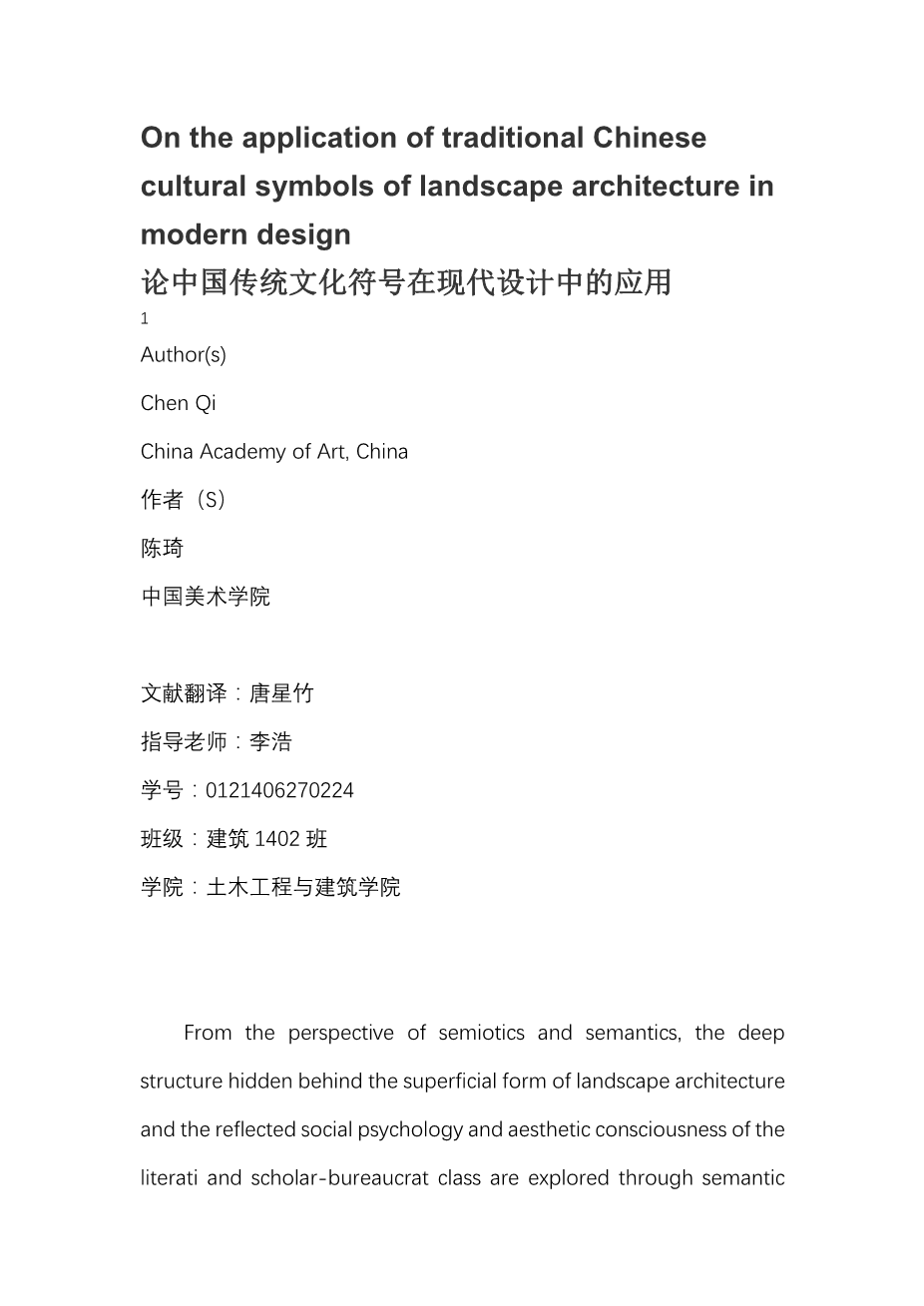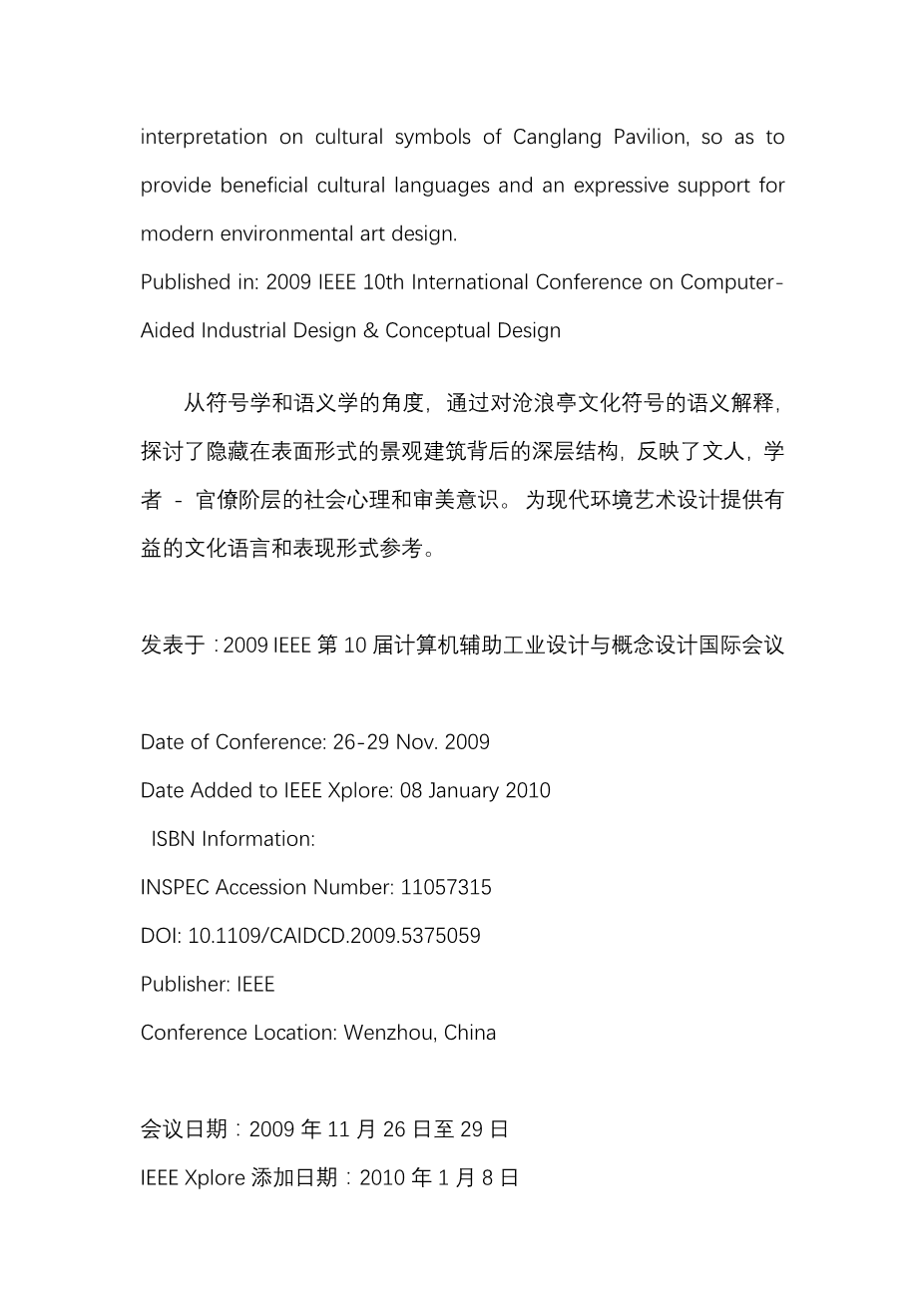On the application of traditional Chinese cultural symbols of landscape architecture in modern design
Author(s)
Chen Qi
China Academy of Art, China
From the perspective of semiotics and semantics, the deep structure hidden behind the superficial form of landscape architecture and the reflected social psychology and aesthetic consciousness of the literati and scholar-bureaucrat class are explored through semantic interpretation on cultural symbols of Canglang Pavilion, so as to provide beneficial cultural languages and an expressive support for modern environmental art design.
Published in: 2009 IEEE 10th International Conference on Computer-Aided Industrial Design amp; Conceptual Design
Date of Conference: 26-29 Nov. 2009
Date Added to IEEE Xplore: 08 January 2010
ISBN Information:
INSPEC Accession Number: 11057315
DOI: 10.1109/CAIDCD.2009.5375059
Publisher: IEEE
Conference Location: Wenzhou, China
SECTION 1.
Introduction
Integrating all kinds of traditional arts, the classical Chinese landscape architecture is a concentration of traditional cultures, which reflects the rational brilliance of the literati and scholar-bureaucrat class. Based on theories of western modern` semiotics and semantics, an analysis is made on the semantic meaning of cultural symbols of Canglang Pavilion in Suzhou and the interpretation of what its architectural languages signify, through which it can be found that the form of landscape architecture and cultural connotation are mutually complementary, with one being the precondition for the other (the form of landscape architecture is a visual embodiment of cultural connotation, while cultural connotation provides an interpretation to the form of landscape architecture). On the basis of collecting memories of Chinese literati and scholars, this paper explores the deep structure hidden behind the superficial form of landscape architecture, aiming to seek for the possibility of solving problems existing in modern environmental art design such as the continuation of historical context, the transmission of regional cultures, the construction of the spirit of place and the application of cultural symbols.
SECTION 2.
Cultural Symbols and Semantic Meaning
Originated from the west, modern semiotics is a general subject studying signs and symbols in the field of humanities. Cultural symbols are created, stipulated and transmitted by members of a cultural community, which reflect the inheritance characteristic of regional culture and cover a wide range of content. Cultural symbols in their narrow sense include language, letters and characters, signs, figures, etc., while in their broad sense, they include art, music, dance, architecture, finery, folk customs, way of act, etc. The semantic meanings of cultural symbols are the cultural connotations expressed by these symbols, that is, the designate of the cultural symbols.
China, as the cradle of eastern culture, has accumulated profound cultural connotations through the five-thousand-year civilization and possessed a great number of cultural symbols. The relationship between cultural symbols and semantic meaning has always been an essential topic of academic culture of Ancient China. The semiotic analysis of the connotations and semantic meanings of traditional Chinese cultural symbols is an important subject of the semiotics study in China. The “designata” contained in visual-form cultural symbols such as vernacular dwellings and gardens reflect the ideals and beliefs of people in Ancient China.
SECTION 3.
Cultural Symbol of Canglang Pavilion and Its Semantic Meaning
Canglang Pavilion is the most ancient landscape architecture in Suzhou, which still preserves the style characteristic of Song Dynasty after being damaged and reconstructed over and over again during the history of a thousand years. It is recognized as a classic among Suzhou Gardens. Its cultural significance is that it reproduced philosophical concepts, cultural psychology, aesthetic consciousness and artistic spirits of the literati and scholar-bureaucrat class on the basis of the emotional representation of the literati and scholar-bureaucrat class. Private gardens constructed by the literati and scholar-bureaucrat class have become cultural symbols of China with rich semantic connotations, reflecting the cultural psychology and cultural values of the nation.
3.1 Site Selection of Canglang Pavilion and Its Cultural Semantic Meaning
Site investigation is one of the most important issues related to garden construction. Ji Cheng, a landscape garden craftsman in the late Ming Dynasty, said in his Craft of Gardens that “to select appropriate sites and build gardens properly”. That is to say, for site selection of garden, not only should the ambient ecological environment be investigated as to whether it is suitable for human habitation, but also the environment should be made to have some poetic value and meaning. There is a stream of clear water winding through Canglang Pavilion, which makes people see water first before entering the garden. Su Shunqin, the initial constructor of the pavilion decided to build Canglang Pavilion beside the water, because he wanted to regard himself as Qu Yuan (a great patriotic poet in Ancient China) and water of Fengxi as that of Canglang so as to express his helplessness in being framed up and ousted and his dissatisfaction against politics of that age. The hills inside Canglang Pavilion are partly revealed and partly enclosed, reflecting the ambivalence of Su Shunqin in refusing the political fames but still unwittingly welcoming them.
It is said in the Craft of Gardens that “the layout and orientation of a garden should be decided according to the conception of gardening with local conditio
全文共26487字,剩余内容已隐藏,支付完成后下载完整资料


英语原文共 40 页,剩余内容已隐藏,支付完成后下载完整资料
资料编号:[1181]


